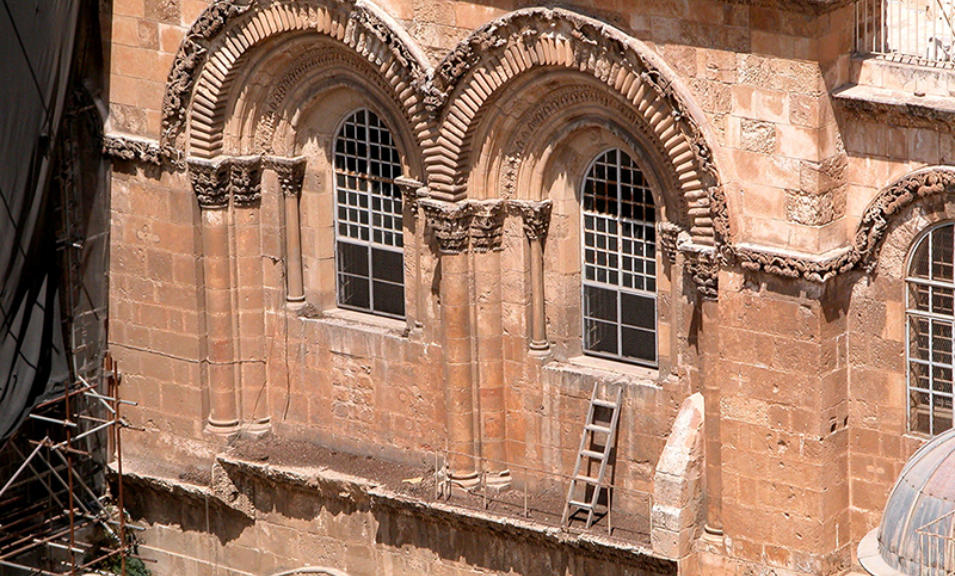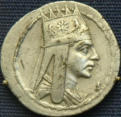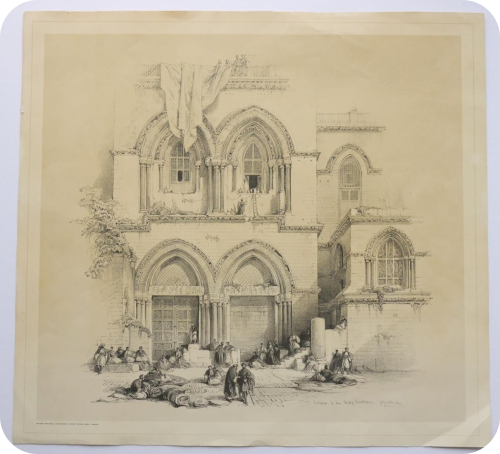

Armenian Jerusalem





The
Church
of
the
Holy
Sepulchre
is
among
the
most
magnificent
religious
monuments
in
Jerusalem.
Christian
pilgrims
–
both
locals
and
foreigners
–
come
here
in
search
of
a
spiritual
experience
because
the
church
is
believed
to
be
the
site
of
Jesus’
crucifixion,
burial,
and
resurrection.
The
size,
splendor,
and
architecture
all
contribute
to
the
church’s
historical
significance.
Within
the
compound
are
also
the
Church
of
St.
Helena
and
the
Chapel
of
the
Finding
of
the
Cross.
The
separate
sections
of
the
compound
were
built
in
different
periods
and
in
different
styles,
but
together
they
form
“a
large,
sprawling,
and rather confusing complex” known as the Church of the Holy Sepulchre.*
1
The
Greek
Orthodox,
Roman
Catholic,
and
Armenian
churches
all
have
the
right
to
worship
in
this
church,
yet
under
an
agreement
known
as
the
Status
Quo,
nothing
can
be
moved
or
changed
without
the
agreement
and
permission
of
all
three
denominations.
As
a
result
of
the
Status
Quo,
a
wooden
ladder
has
been
standing
in
the
same
location
above
the
entrance
of
the
church
for
around
200
years,
an
inexplicable
outcome
of
religious
stubbornness.
The
exact
date
on
which
the
ladder
was
placed in its present position is unknown, but its first evidence comes from the mid-1800s.
To
shed
some
light
on
the
mystery
of
how
it
was
placed
there,
let
me
recount
some
of
the
events
that
took
place
over
the
last
two
millennia
in
the
history
of
this
holy
site.
While
today
the
church
is
located
at
the
center
of
the
Christian
Quarter
of
the
Old
City,
Golgotha
hill
was
originally
located
outside
Jerusalem’s
city
walls.
In
135
AD,
Jerusalem
became
a
Roman
colony
(Aelia
Capitolina),
and
emperor
Hadrian
built
a
temple
for
Aphrodite
in
this
location,
which
made
it
easier
for
Christian
tradition
to
mark
the
place
as
the
credible
location
of
Golgotha.
Not
until
Helena,
the
mother
of
emperor
Constantine,
came
to
Jerusalem
in
326
AD
was
the
first
church
built
on
the
site.
In
614
AD,
Constantine’s
basilica
was
destroyed
by
the
Persians
under
Khosrau
II,
but
in
630
AD,
the
Byzantine
emperor
Heraclius
marched
triumphantly
into
Jerusalem
and
rebuilt
the
church.
Under
Muslim
rule
(starting
in
637),
it
remained
a
Christian
church
until
in
1009
the
Fatimid Caliph Al-Hakim bi-Amr Allah ordered its complete destruction.
Almost
a
century
later,
the
church
was
restored
to
a
lower
standard
by
the
Crusaders,
and
it
has
suffered
severe
damage
since
then,
caused
by
fires,
earthquakes,
and
general
neglect.
In
an
attempt
to
repair
it,
the
Franciscans
conducted
significant
renovations
in
1555,
yet
in
more
recent
times,
a
fire
(1808)
and
an
earthquake
(1927)
have
done
extensive
damage.
Today,
the
church
is
a
result
of
programmed
restorations
carried
out
in
1957
and
again
in
2017
–
only
after
long-awaited
agreements
had
been
reached
among
the
six
different
Christian
denominations.
The
Greek
Orthodox,
Armenian
Orthodox,
Roman
Catholic,
Coptic,
Syrian
Jacobite,
and
Ethiopian
Orthodox
faiths
all
have
the
right
to
worship
in
this
Church,
yet
according
to
the
Status
Quo
nothing
can
be
moved
or
changed
unless
all
of
these
agree
and
give their permission.
“The
Status
Quo
has
referred
to
the
customary
set
of
arrangements
regulating
possession,
usage,
and
liturgy
at
the
holy
places.
It
allows
rivals
to
live
and
worship
alongside
each
other
in
a
confined
space.
Without
it
there
would
be
a
free-for-all.
Because
the
major
communities
realize
this,
they
insist
on
its
strict
observance,
though
it
includes
many
inconvenient
provisions.
The
Status
Quo
is
a
seamless
web:
if
you
pick
and
choose,
it
will fall apart. Change is not completely ruled out, however, provided the parties can amicably agree.”*
2
Over
the
centuries,
the
Catholic
and
Orthodox
churches
−
known
in
Jerusalem
as
Latins
and
Greeks
–drifted
apart
for
cultural,
political,
and
theological
reasons.
Their
rivalry
for
control
of
the
Holy
Sepulchre
has
reflected
the
wider
conflict.
When
the
Crusaders
captured
Jerusalem
in
1099,
they
appointed
a
Latin
Bishop
to
the
vacant
Jerusalem
patriarchate,
traditionally
occupied
by
an
Orthodox
archbishop.
The
consecration
of
a
new
Holy
Sepulchre
in
1149
marked
the
high
point
of
Latin
primacy.
When
Saladin
retook
Jerusalem
in
1187,
he
restored
the
patriarchal
throne
to
the
Greek
Orthodox.
During
the
Ottoman
era
(1516–1917),
the
Greeks
and
Latins
contested
control
of
the
edifice.
“They
fought
on
three
fronts:
in
the
church
with
stones
and
staves;
through
the
local
Moslem
religious
courts
with
ancient
deeds,
sometimes
forged;
and
in
the
corridors
of
power
in
Istanbul,
where
bribes
and
diplomatic
pressure
were
used
to
obtain
imperial
“firmans”
bestowing
rights
of
possession and usage.”*
3
This
rivalry
required
the
establishment
of
the
Status
Quo,
and
the
rule
was
imposed
by
the
Ottoman
Turks
in
1757
and
reaffirmed in 1852.
The
holy
places
affected
by
the
Status
Quo
and
its
general
principles
are:
1.
The
Church
of
the
Holy
Sepulchre
with
all
its
dependencies;
2.
The
Deir
al
Sultan
Ethiopian
monastery
located
on
the
roof
of
the
church;
3.
The
Sanctuary
of
the
Ascension
on
the
Mount
of
Olives;
4.
The
Tomb
of
the
Virgin
(near
Gethsemane);
and
5.
The
Church
of
the
Nativity.
The
Milk
Grotto and Shepherd’s Field near Bethlehem are also generally subject to the Status Quo.
In
all
matters
of
principle
relating
to
the
Status
Quo
in
the
Christian
holy
places,
only
the
Orthodox,
Latin,
and
Armenian
Orthodox
rites
are
considered.
This
follows
the
arrangement
established
under
the
Turkish
Government
and
corresponds
to
the
administrative
organization
of
rayahs,
the
non-Muslim
Ottoman
nations,
into
millets
that
correspond
to
these denominations − the other Orthodox Eastern rites being grouped with the Armenians.*
4
Given
that
the
immovable
ladder
is
a
result
of
the
Status
Quo
and
its
affirmation
that
nothing
can
be
moved
or
changed
unless
the
three
denominations
involved
in
the
agreement
reach
a
consensus,
its
presence
and
the
surrounding
discussions reflect the seriousness and obscurity of this matter.
The
ladder
cannot
be
removed,
yet
it
seems
to
have
been
replaced
a
few
times
(due
to
deterioration),
existed
in
different versions, and moved from one window to the other. It even disappeared for a few hours at one point.
A
five-stepped
wooden
ladder
rests
on
the
ledge
of
the
right
window
above
the
main
entrance
and
can
be
seen
by
anyone
coming
into
the
plaza
of
the
Church
of
the
Holy
Sepulchre.
No
reliable
source
of
information
regarding
who
placed
the
ladder
seems
to
exist.
We
do
not
know
for
sure
when
it
was
placed
or
why
it
sits
in
this
particular
location.
Yet
there
are
many
interesting
narratives
that
have
been
circulated
over
the
internet.
Only
a
few
people
have
gathered
as
much
information
as
James
E.
Lancaster
(PhD)
who,
since
1998,
has
been
engaged
in
revealing
various
stories
related
to
the
ladder.
But in the following pages, I will present new information not mentioned previously or by Lancaster.
The
first
and
earliest
known
documentation
of
the
ladder’s
existence
comes
from
the
painter
Clarkson
Frederick
Stanfield
(December
3,
1793–May
18,
1867),
who
was
a
prominent
English
marine
painter.
His
painting,
dated
1834,
shows
the
exterior of the church with a ladder placed on the right window ledge, exactly the same location where it appears today.
The
second
earliest
documentation
comes
from
the
famous
painter
A.
David
Roberts
(Fig.
1).
The
cover
page
of
his
lithograph
album
titled
The
Holy
Land
Vol.
3,
published
between
1842
and
1849,
clearly
shows
the
ladder
standing
on
the
window ledge, the same way it is seen today.
Another
picture
I
was
fortunate
to
stumble
upon
in
the
Rockefeller
Museum
in
Jerusalem
dates
the
ladder
back
to
1857.
During
my
search
for
information,
in
the
section
displaying
the
original
marble
lintels
of
the
church
doors,
I
found
a
picture
that
displays
the
church’s
façade
with
the
lintels
above
the
doors
prior
to
their
removal.
The
ladder
can
be
clearly
noted,
positioned
in
the
same
location
as
today
(Fig.
1).
Other
nineteenth-century
images
of
the
ladder
have
been
included
in Dr. Lancaster’s paper and are dated 1840–1870s.*
5
Thus,
as
the
earliest
documentation
seems
to
date
the
ladder
back
to
1834,
the
ladder
is
at
least
178
years
old,
and
it
appears
that
it
has
not
been
moved
since.
However,
comparing
the
different
pictures
of
the
ladder,
I
would
like
to
suggest
that
the
ladder
has
been
renewed
about
every
fifty
years
because
it
wears
out.
Pictures
have
shown
ladders
with
five
and
six
steps. Fig. 2 shows the six-stepped-ladder picture to the right dated 1840.
So
let
us
take
a
look
at
the
various
narratives.
During
the
data
collection
for
this
research,
I
noted
many
different
explanations for the existence of the ladder. However, none could be verified as accurate.
Simon Montefiore in his bestseller Jerusalem: The Biography describes it as:
“…
a
little
ladder
belonging
to
the
Armenians
on
the
balcony
outside
the
right
hand
window
in
the
façade
of
the
church
which
tour
guides
claim
can
never
be
moved
without
other
sects
seizing
it.
In
fact,
the
ladder
leads
to
the
balcony
where
the
Armenian
superior
used
to
drink
coffee
with
his
friends
and
tend
his
flower
garden;
it
is
there
so
that
the
balcony
can
be
cleaned.”*
6
The
author
refers
to
the
ladder
in
a
footnote
while
writing
about
disputes
that
took
place
during
the
Holy
Fire
ceremony
in
2005.
But
he
does
not
give
any
citation
or
reference
for
his
information
on
how
he
concludes
that
the
ladder’s
function is to allow the Armenian superior to tend to his flowers!
Yet
what
seems
to
be
agreed
upon
in
most
narratives
I
researched
is
that
the
windows
belong
to
the
Armenians,
while
the
base
or
porch
belongs
to
the
Greek
Orthodox.
According
to
an
article
published
in
the
Biblical
Archaeological
Review
in
January/February 2010:
“…the
ladder
must
not
be
removed
because
it
sits
on
property
of
the
Greek
Orthodox
…
but
leans
on
property
of
the
Armenians…; neither group therefore controls the ladder, nor may either remove it.”*
7
Older
narratives
claim
that
the
windows
belong
to
the
Armenians
and
that
the
ladder
is
used
to
access
the
porch
during the “washing of feet” and other ceremonies. In the article “The Status Quo in the Holy Places,” we read:
“Above
the
doorway
runs
a
classical
cornice,
a
relic
of
the
Byzantine
buildings.
This
is
reached
from
the
windows
of
the
Armenian
Chapel
of
St.
John,
and
this
Community
has
the
use
thereof
on
the
occasion
of
the
festival
ceremonies
that
take place in the Courtyard. The upper cornice is used in the same manner by the Orthodox.”*
8
While
searching
for
additional
information,
I
made
a
number
of
visits
to
the
church
in
an
effort
to
interview
clergy
and
priests
on
what
they
know
about
the
ladder.
These
attempts
have
not
been
very
fruitful!
Fr.
Alkimos,
a
Greek
Orthodox
priest
who
was
guiding
a
pilgrimage
group
from
Greece,
said
that
he
had
no
knowledge
of
why
the
ladder
was
there
or
what
its
origins were; his only response was: “Status Quo.”
A Coptic priest was surprised to know that this ladder had significance, he said, “I never paid attention to it!”
Inside
the
Armenian
section
of
the
church,
a
young
Armenian
priest
with
broken
English
seemed
relaxed
and
willing
to
share
his
limited
views
after
identifying
me
as
a
fellow
Armenian:
“This
ladder
is
very
old;
it
is
very
historical
and
very
important…lots of history…”
My
final
hope
was
to
get
an
accurate
answer
in
the
Orthodox
section,
St.
James
Church.
I
had
received
guidance
from
the
patriarchate’s
spokesperson,
Father
Issa
Misleh,
who
insisted
that
the
best
people
to
give
answers
would
be
the
Arab
Christian
wardens
ministering
there.
Yet
this
inquiry
was
also
without
success
as
no
one
was
able
to
comment
or
give
information. I was then advised to interview Fr. Aristarchus, the patriarch’s secretary − who was out of the country.
I
returned
to
written
sources
in
my
attempts
to
collect
information
on
the
function
of
the
ladder
and
seemed
to
have
better
luck.
According
to
Aviva
Bar-Am
in
Beyond
the
Walls:
Churches
of
Jerusalem:
“the
ladder…
was
used
over
a
century
ago for hauling food up to Armenian monks locked in the church by Turks.”*
9
In
order
to
verify
that
the
function
of
the
ladder
was
to
haul
up
food
for
locked-up
monks,
I
had
to
find
out
why
monks
were
locked
up
inside
the
church.
Lancaster’s
document
notes:
“The
ladder
was
first
introduced
at
a
time
when
the
Ottomans
taxed
Christian
clergy
every
time
they
left
and
entered
the
Holy
Sepulchre.
The
clergy
who
served
the
church
reacted
by
leaving
the
church
as
rarely
as
possible.
They
set
up
living
quarters
within
the
church.”*
10
The
ladder
was
placed
on the balcony to allow the clergy to get fresh air and sunshine, and to grow vegetables!
In
an
interview,
the
late
Kevork
Kahvedjian,
owner
of
the
Elia
Photo
Service
and
son
of
the
famous
photographer
Elia
Kahvedjian,
told
me
that
the
detailed
story
of
the
ladder
was
passed
down
from
one
generation
to
another,
and
this
is
how
he narrated it to me:
“During
the
Ottoman
period,
constant
clashes
between
the
Armenians,
Orthodox,
and
Catholics
became
very
irritating
to
the
sultan
who
ordered
that
the
church
doors
should
be
closed
and
all
the
priests
remain
locked
up
inside
until
they
agreed
to
settle
their
differences…
This
resulted
in
a
three-month-long
closure
of
the
church
because
it
seemed
impossible
to
reach
an
agreement
…
During
those
three
months,
the
ladder
was
placed
by
the
Armenian
priests
and
a
rope
was
brought
down
to
haul
food
and
supplies
up
into
the
Church…
The
Orthodox
had
their
own
ladder
in
the
back
side
of
the
Church…
When the agreement was reached, everything had to remain in its exact place, and so remained the ladder.”
It
seems,
therefore,
that
ladder’s
origin
is
related
to
a
kind
of
“lock-up”
that
was
directly
or
indirectly
imposed
by
the
Ottomans on the church, and thus its function begins to make sense.
In
some
of
the
stories
around
the
Status
Quo,
I
seemed
to
detect
disappointment
regarding
the
general
dispute
among
various
Christian
denominations.
Many,
if
not
all,
describe
a
desire
to
see
the
Christians
more
united
and
to
witness
a
change
towards
mending
the
currently
broken
relations.
Yet
even
if
relations
seem
to
be
frozen,
the
ladder
has
almost
certainly
been moved!
On
February
4,
2009,
a
student
in
an
Israeli
tour
guide
licensing
course
noticed
that
the
ladder
had
been
moved
from
its location under the right window to the left window. His camera captured the ladder in its current location.*
11
The
ladder
was
moved
back
to
its
standard
location
later
on
and
sits
there
today
untouched
and
unmoved.
There
has
been no source of information as to what happened and who moved the ladder.
The
ladder
even
disappeared
for
a
few
hours.
Lancaster,
in
his
article
“The
Church
and
the
Ladder:
Frozen
in
Time,”
mentions
a
unique
and
bizarre
event:
in
1997,
someone
named
Andy
took
the
opportunity
to
sneak
into
the
church
and
pull
the
ladder
inside.
The
picture
in
Fig.
5
shows
an
unnamed
accomplice
hauling
the
ladder
through
the
window.
After
this
act,
a new solid frame with a lock was placed at the window to make sure that this doesn’t happen again.
In conclusion, we apparently can be sure of three points:
The ladder is there because of the Status Quo agreement. It reflects the seriousness and significance of this treaty.
The
windows
belong
to
the
Armenians;
but
because
the
ladder
stands
on
a
cornice
that
belongs
to
the
Greek
Orthodox,
no one has the exclusive ownership. Thus, a decision regarding its fate needs the consensus of all denominations.
The
function
of
the
ladder
is
most
probably
related
to
a
“lock-up”
that
was
imposed
by
the
Ottomans
during
their
rule
in Jerusalem; it facilitated access to the outer section of the church in order to haul up food for the priests.
Finally,
despite
the
many
years
of
disagreement
and
quarrel,
the
Status
Quo
provides
a
reasonable
solution
for
the
complex
issue
of
sharing
a
sacred
space.
In
my
opinion,
such
a
system
could
work
between
Palestinians
and
Israelis
when
it
comes
to
the
sovereignty
of
political
territory.
Using
the
Holy
Sepulchre
as
a
model,
I
believe
that
conflicting
ideas
could
be
settled peacefully if an agreement such as the Status Quo were applied in the final negotiations on Jerusalem.
*1 Rivka Gonen, Biblical Holy Places: An Illustrated Guide, Jerusalem: Palphot Publications, 1999.
*2
Raymond
Cohen,
Saving
the
Holy
Sepulchre:
How
Rival
Christians
Came
Together
to
Rescue
Their
Holiest
Shrine,
New
York:
Oxford
University
Press,
2008.
*3 Cohen.
*4 Lionel G.A. Cust and Abdullah Effendi Kardus, The Status Quo in the Holy Places, London, H.M.S.O, 1929.
*5 James E. Lancaster, “The Church and the Ladder: Frozen in Time,” 1998, available at http://coastdaylight.com/ladder.html.
*6 Simon Sebag Montefiore, Jerusalem: The Biography, London: Weidenfeld & Nicolson, 2012.
*7 Danny Herman, “Strata: Who Moved the Ladder?” Biblical Archaeology Review, 36:1.
*8 Cust and Kardus, The Status Quo.
*9 Aviva Bar-Am, Beyond the Walls: Churches of Jerusalem, Jerusalem: Ahava Press, 1998.
*10 Lancaster.
*11 Herman, “Strata.”
(Simon
Azazian
is
the
Director
of
Information
and
PR
at
the
Palestinian
Bible
Society.
He
is
the
chief
editor
of
Jerusalem
Unites
Us
magazine
and
is
also
a
talented
musician.
He
also
holds
a
BA
in
English
language
and
literature
from
Bethlehem
University,
and
a
master’s
degree
in
Jerusalem
Studies
from
Al-Quds
University).
(Courtesy “This Week in Palestine”)






















